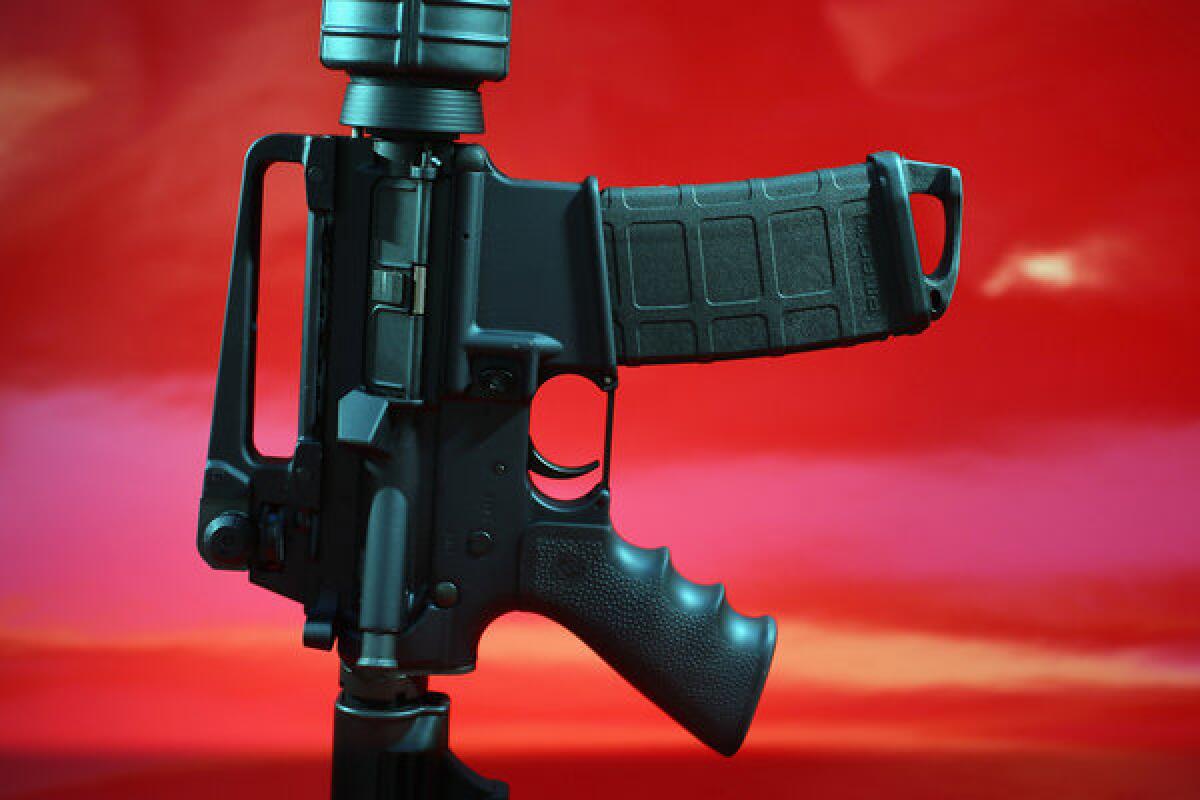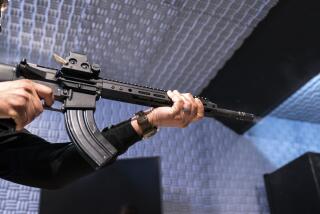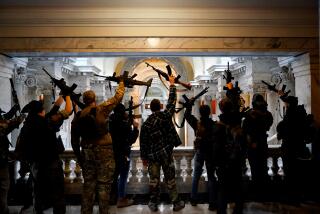Illegally obtained assault rifles key in recent public shootings

Two deadly weeks. Three high-profile public shootings. Three assault rifles conceived for military use, and three men who weren’t supposed to have them.
As an ex-con, William Spengler was barred from having guns. But when he opened fire on Webster, N.Y., firefighters on Christmas Eve, federal law enforcement sources have told the Los Angeles Times that he did so with guns from someone else who had also gotten them illegally.
In an interview Thursday on CNN, David Keene, president of the National Rifle Assn., said this is a particularly critical problem.
“Most guns that are used illegally in this country are either bought on the black market or are stolen,” he said, responding to a question about a New York newspaper that published the names and addresses of legal gun owners.
As debate churns over the nation’s gun policies, every passing shooting enters a new data point in the broader political tabulations about how to prevent public shootings that some experts say are happening no more often than usual.
Much of the debate has focused on AR-15-style assault rifles -- “modern sporting rifles,” as some sellers market them -- that have swelled in popularity in recent years. Gun manufacturer Freedom Group Inc., which owns Bushmaster, has estimated sales for such guns grew at a 27% compound annual growth rate between 2007 and 2011.
AR-15s were originally designed to penetrate a steel helmet from 500 yards away. Drawn from the U.S. military’s desire to compete with the battlefield rise of the AK-47 among Communist forces in the 1950s and ‘60s, the AR-15 found widespread use among American troops during the Vietnam war under a modified military version, the M-16.
Semiautomatic variants have since been replicated for the civilian market by companies like Bushmaster, ArmaLite Inc. and Colt, which owns the trademark on the term “AR-15,” though the term is still commonly used to describe similarly configured rifles.
Today, most owners, citing the AR-15’s range and accuracy, buy them for casual target shooting and home defense, according to a 2010 online survey by the National Shooting Sports Foundation. Of the more than 7,000 respondents, 99% were men and often had military or law enforcement backgrounds. Oak Creek, Wis., Sikh temple shooter Wade Page was brought down by a responding officer with an AR-15.
Americans can own these weapons legally, but the shooters in the three recent cases did not.
----
It was Christmas Eve, and firefighters were responding to a house fire in the otherwise sleepy lakeside community of Webster, N.Y., when muzzle flashes lit up the morning dark.
“We are being shot at, multiple firemen down, multiple firemen shot,” one firefighter radioed in. “I am shot. I think it was an assault rifle. We have multiple firemen down.”
Spengler, 62, was doing the shooting. He left a typewritten note saying that killing was the thing he did best, but as a felon, he was barred from possessing guns; he’d killed his grandmother with a hammer in 1980 and served nearly 18 years in prison before his release.
After he’d ambushed four firefighters and then shot himself in the head, officials found him with a Bushmaster .223 rifle with a flash suppressor -- which helps shooters from getting blinded by their own fire -- and a Mossberg 12-gauge shotgun that had both been “illegally purchased” within the last several years by “someone else,” federal officials told the Los Angeles Times on Wednesday.
Spengler also had a .38-caliber Smith & Wesson revolver, these officials said, which he’d purchased before his conviction.
“He was equipped to go to war and kill innocent people,” Webster Police Chief Gerald Pickering said.
Police suspect he used the Bushmaster to do his killing. One surviving firefighter’s shoulder blade was broken in multiple places, with a bullet also puncturing his lung; the other survivor took a round that splintered inside his gut, with some fragments lodged near his spine. Officials said Wednesday they expected both men would be upgraded to “satisfactory” condition.
The same style of assault rifle was used in a very different attack two weeks earlier and more than 2,000 miles away.
Jacob Tyler Roberts, 22, who had been known as a nice guy with a sense of humor, clutched an AR-15-style rifle as he jogged through a Macy’s store at a mall in Clackamas, Ore., that was jammed with holiday shoppers. The gun -- a Stag Arms AR-15 variant, according to the Oregonian -- wasn’t his. He’d stolen it from a friend who owned it legally.
“I am the shooter!” he shouted right before opening fire near the food court, one witness said. He killed a 54-year-old hospice nurse and a 45-year-old kiosk retailer.
Roberts also shot 15-year-old Kristina Shevchenko while she tried to get away, with the bullet fragmenting inside her chest and collapsing her lung. She kept running and survived; her surgeon praised her toughness, but added that the wound looked like something he would have seen on a battlefield.
Roberts then used the gun to shoot himself in the head.
AR-15-style rifles, with their distinctive military silhouettes, fire .223-caliber bullets that were invented specifically for use in the weapon. The .223 round was small but fast by mid-century military standards, capable of delivering bullets that could penetrate tough metals or fragment when they hit flesh, causing greater injury.
C.J. Chivers’ history of assault rifles, “The Gun,” recounted a Colt salesman’s pitch to the Glastonbury, Conn., Police Department in 1960 in which he used an AR-15 to fire a .223 bullet through a 1955 Pontiac Tudor from 60 yards away, penetrating both doors and the buckets of water he’d placed on the driver and passenger seats.
“A single bullet fired by an AR-15, by the implicit wink in this kind of statement, was capable of a bad-guy-stopping twofer,” Chivers wrote. “It could pass through a door, then one man, and then another man and then out another door. Bonnie and Clyde would have no chance.”
A Colt company summary of the AR-15’s capabilities bragged that the gun, with its relatively small but high-velocity .223 round, would “penetrate most commercially used building materials.”
Half a century later, when 20-year-old Adam Lanza shot his way into Sandy Hook Elementary School in Newtown, Conn., on Dec. 14, he carried a Bushmaster .223 -- among the most popular of the civilian AR-15-style rifles -- plus a Glock 10-millimeter pistol and Sig Sauer handgun.
Earlier in the week, he’d tried to buy a rifle at a local gun store but didn’t want to wait for the 14-day background check, law enforcement officials said.
So he took the guns legally registered to his mother, who was comfortable around guns, according to police sources. She was the first to be killed. Lanza shot her in the head four times with a .22 rifle. They found her body in bed.
Lanza, a good student known more for the briefcase he used to carry to class, upgraded to the Bushmaster for Sandy Hook.
He came with hundreds of rounds and multiple 30-round magazines for the Bushmaster. At close range, he repeatedly shot each of the 20 children and six staffers killed.
When the shooting stopped and it came time to kill himself, he switched to a pistol. He put it to his head.
ALSO:
N.Y. gunman wrote that ‘killing people’ was what he did best
Newtown desperately needed Christmas after Sandy Hook massacre
Louisiana town is up in arms over resident’s outdoor Christmas lights
Times staff writer Richard A. Serrano contributed to this report.
More to Read
Sign up for Essential California
The most important California stories and recommendations in your inbox every morning.
You may occasionally receive promotional content from the Los Angeles Times.











